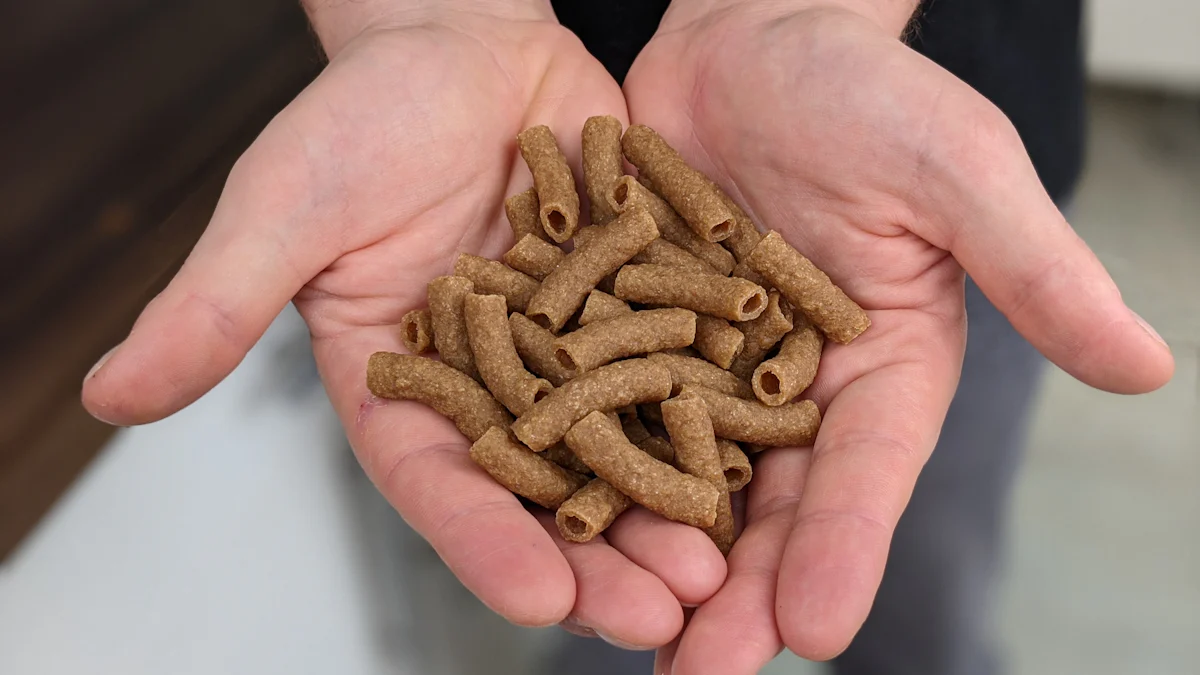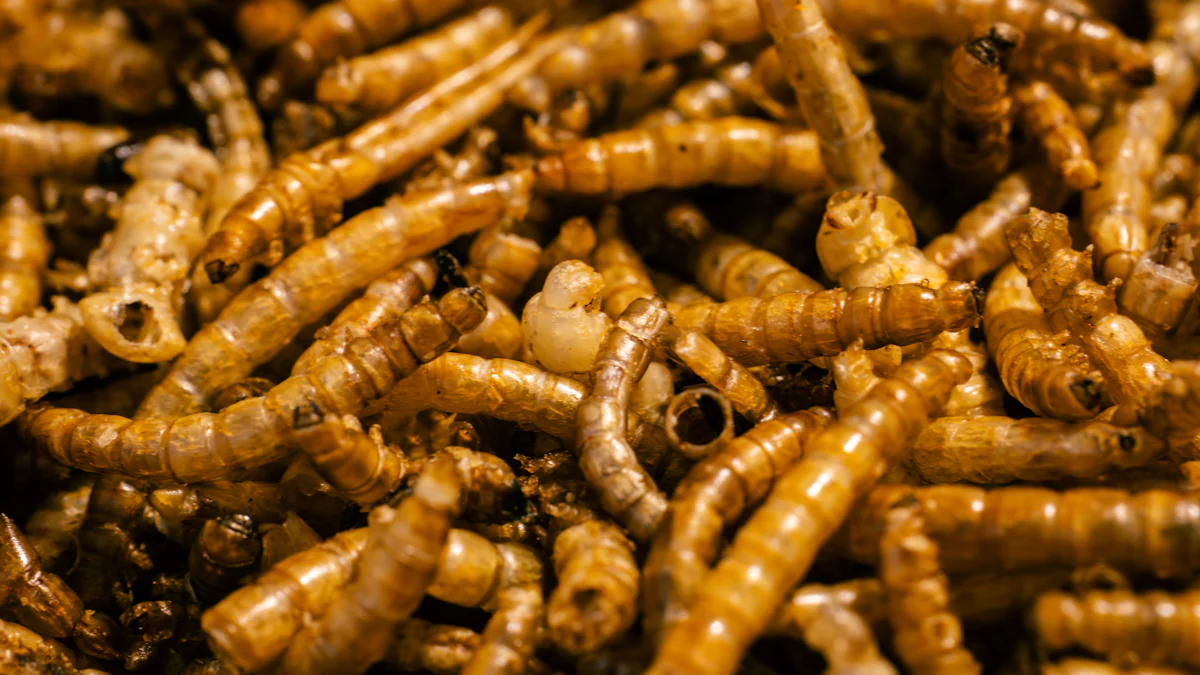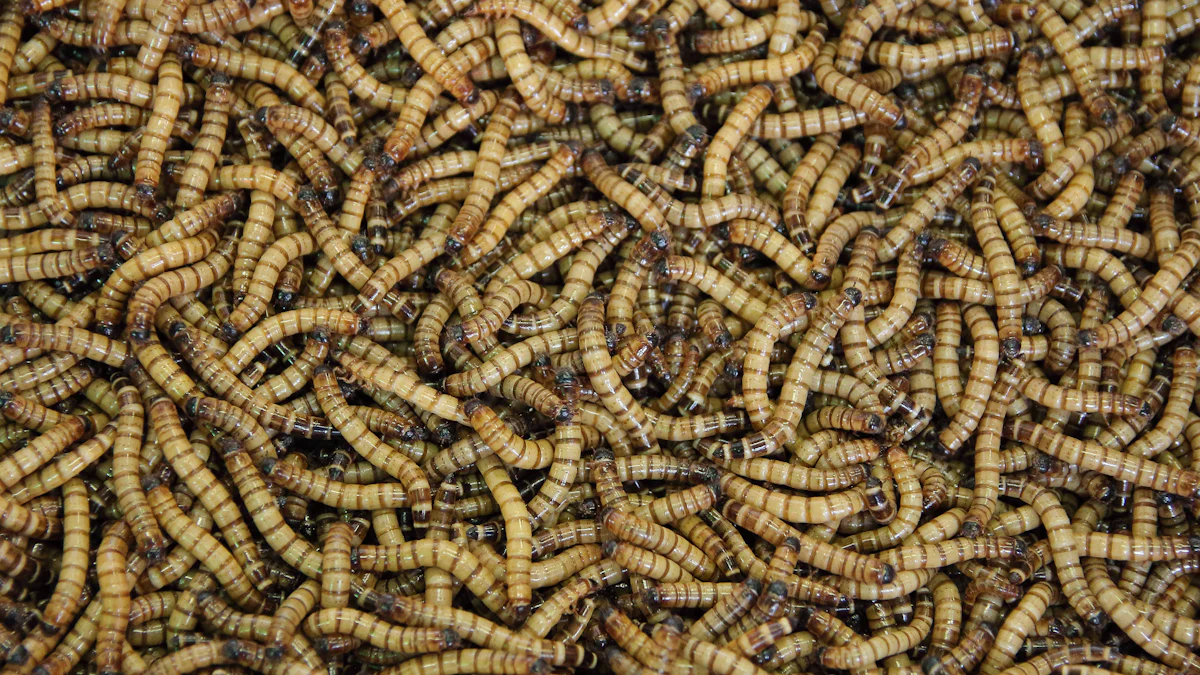
Feeding your chickens dried mealworms is a great way to give them a protein-packed treat. You should aim to feed each chicken about 10-12 mealworms daily or roughly 1-2 tablespoons. Alternatively, offering them every second day works just as well. Poultry nutrition experts suggest that dried mealworms should make up no more than 10% of a chicken’s daily diet. This ensures they get a balanced mix of nutrients from their regular feed.
Moderation is key when it comes to dried mealworms for chickens. These treats are nutrient-dense but high in fat, with about 25-30% fat content. Overfeeding can lead to weight gain, fewer eggs, and even laying difficulties. Just 0.4 ounces of mealworms can fulfill a chicken’s daily fat needs, so it’s important not to overdo it. Stick to natural, dehydrated mealworms and always prioritize their regular feed and fresh water.
Key Takeaways
- Give your chickens 10-12 dried mealworms each day or 1-2 tablespoons every other day for extra protein.
- Keep dried mealworms to 10% of their daily food to avoid weight gain and keep their diet balanced.
- When chickens molt or in bad weather, feed more mealworms to help with energy and growing feathers.
- Start giving chicks mealworms after six weeks. Begin with small amounts to prevent stomach problems.
- Use dried mealworms as a treat or reward to teach good behavior and keep chickens entertained.
Why Are Dried Mealworms Good for Chickens?

High Protein Content for Growth and Health
Dried mealworms are a powerhouse of protein, making them an excellent addition to your chickens’ diet. With about 52-53% protein content, they outshine other common feed options like grains or even black soldier fly larvae. This high protein level is essential for your chickens’ growth, muscle development, and tissue repair. It also helps them stay active and healthy.
Mealworms are rich in essential amino acids, which play a key role in building strong muscles and maintaining overall health. They also contain vitamins like B12 and B6, along with minerals such as iron, selenium, and zinc. These nutrients support your chickens’ immune system and keep them in top shape. By feeding your flock around 10 mealworms every second day, you can give them a natural, protein-packed boost.
Support During Moulting and Egg Production
Moulting and egg production are demanding periods for chickens. During molting, they shed old feathers and grow new ones, which are made up of 85-90% protein. Dried mealworms provide the extra protein your chickens need to regrow feathers quickly and maintain their body temperature. This helps them stay comfortable and healthy.
For laying hens, mealworms are equally beneficial. The protein and fatty acids in mealworms improve egg quality and can even extend the laying period. Vitamins and minerals like selenium and zinc also strengthen the immune system, ensuring your hens stay productive and resilient. Offering 100% natural dehydrated dried mealworms during these times can make a noticeable difference in their health and performance.
Energy Boost in Extreme Weather
Chickens often struggle to maintain their energy levels during extreme weather, especially in winter. Dried mealworms are an excellent source of fat, which provides the energy your flock needs to stay warm and active. Increased protein intake during colder months also helps chickens maintain their body temperature and overall health.
In addition to keeping them warm, the energy from mealworms can improve egg production and quality, even in challenging conditions. By feeding your chickens dried mealworms for chickens, you’re giving them a natural way to stay strong and productive, no matter the weather.
How Much Dried Mealworms for Chickens?
General Feeding Guidelines
When it comes to feeding dried mealworms to your chickens, sticking to general guidelines ensures they stay healthy and happy. Adult chickens typically need about 10-12 mealworms daily. If you prefer, you can feed them every second day instead. This amount provides a great protein boost without overloading their diet. For a flock of 10 chickens, you’d need around 100-200 grams of mealworms daily, depending on their activity levels and other food sources.
During times of stress, like molting or extreme weather, you can increase the amount slightly. Doubling their intake during these periods helps them cope better. However, remember that dried mealworms should only make up about 10% of their daily feed. For example, if your chickens eat 1/2 cup of feed daily, limit mealworms to 1 tablespoon. Always prioritize their regular feed and fresh water to maintain a balanced diet.
Adjusting Quantity for Age and Size
Not all chickens are the same, so you’ll need to adjust the amount of mealworms based on their age and size. Larger chickens can handle more mealworms than smaller ones. Adult chickens generally thrive on 10-20 grams of mealworms daily, but younger chicks require a different approach.
If you’re introducing mealworms to chicks, wait until they’re about six weeks old. Start with small amounts since their growing bodies need higher protein levels for development. Gradually increase the quantity as they grow. Keep an eye on their behavior and energy levels to ensure they’re getting just the right amount.
Special Needs: Moulting, Breeding, or Recovery
Chickens have unique nutritional needs during molting, breeding, or recovery. These periods demand extra energy and protein, making dried mealworms an excellent choice. During molting, chickens shed old feathers and grow new ones, which are mostly made of protein. Feeding them 20-24 mealworms daily during this time can speed up feather regrowth and keep them comfortable.
Breeding hens also benefit from the high protein content in mealworms. It supports egg production and improves egg quality. If your chickens are recovering from illness or injury, mealworms can help them regain strength. Just remember to stick to 100% natural dehydrated dried mealworms for the best results.
Factors That Influence Mealworm Quantity
Seasonal and Weather Changes
The time of year and weather conditions can change how much dried mealworms your chickens need. During molting season, which usually happens in autumn and spring, your chickens lose their feathers and grow new ones. This process requires a lot of protein, and dried mealworms are perfect for helping them recover quickly. Feeding around 10 mealworms per chicken every second day during this time can make a big difference in their health and comfort.
Extreme weather also plays a role. In winter, chickens need extra energy to stay warm, while in summer, they may need more nutrients to handle the heat. Doubling their mealworm intake during these times can give them the boost they need. Whether it’s freezing cold or scorching hot, mealworms help your flock stay strong and healthy.
Activity Levels and Energy Needs
Not all chickens are equally active, and their energy needs vary. If your chickens are free-range and spend their days foraging, they’ll burn more calories and need more protein. Dried mealworms are a great way to meet these extra demands. Active hens, especially those laying eggs, benefit from the added protein, which supports growth and improves egg production.
On the other hand, less active chickens or those confined to a coop may not need as many mealworms. Keep an eye on your flock’s behavior. If they’re constantly on the move, consider increasing their mealworm intake slightly to match their energy levels.
Balancing Mealworms with Other Feed
While dried mealworms for chickens are a fantastic treat, they should never replace a balanced diet. Overfeeding mealworms can lead to health problems like obesity or nutritional imbalances. To keep your flock healthy, mealworms should make up no more than 10% of their total diet.
Think of mealworms as a supplement to their regular feed, which should include grains, greens, and grit. For example, if your chickens eat 1/2 cup of feed daily, limit mealworms to about 1 tablespoon. This ensures they get all the nutrients they need while still enjoying the benefits of mealworms. Moderation is key to keeping your chickens happy and healthy.
How to Feed Dried Mealworms to Chickens

Mixing Mealworms with Regular Feed
Adding dried mealworms to your chickens’ regular feed is one of the easiest ways to boost their protein intake. You can start by tossing a handful of mealworms into their feed and mixing it well. This ensures every chicken gets a share without overeating. If you’re introducing mealworms for the first time, begin with small amounts to avoid upsetting their digestion. Gradually increase the quantity as they get used to it.
For variety, sprinkle mealworms directly into their feeder or mix them with grains and pellets. This keeps their diet interesting and encourages them to eat more. Always provide fresh water alongside their feed to help with digestion. Remember, mealworms are a supplement, not a replacement for their main diet. Feed around 10 mealworms per chicken every second day to maintain a healthy balance.
Scattering Mealworms for Foraging
Chickens are natural foragers, and scattering dried mealworms in their run is a fantastic way to engage this instinct. Tossing mealworms across the ground encourages them to scratch, peck, and search for their treat. This activity keeps them physically active and mentally stimulated, reducing stress and boredom.
Foraging also mimics their natural behavior, which is essential for their overall well-being. It’s especially helpful for free-range chickens, as it gives them a chance to explore and stay busy. If you have a confined flock, scattering mealworms can make their environment more enriching. Just make sure to scatter the mealworms evenly so every chicken has a chance to find some.
Using Mealworms as Treats or Rewards
Dried mealworms make excellent treats or rewards for your flock. They’re packed with protein, which supports feather regrowth during molting and boosts overall health. The natural fats in mealworms also improve feather shine and egg quality. Plus, they’re loaded with essential vitamins and minerals like B vitamins, potassium, and iron.
Using mealworms as a reward is a great way to train your chickens or encourage good behavior. For example, you can reward them for returning to the coop or coming when called. Mealworms are also convenient to store since they have a long shelf life and don’t spoil like live treats. Just remember to stick to 100% natural dehydrated dried mealworms for the best results.
Troubleshooting: What If Chickens Don’t Eat Dried Mealworms?
Sometimes, chickens might turn their beaks up at dried mealworms. Don’t worry—this is pretty common, and there are a few easy fixes to get them interested.
Rehydrating Dried Mealworms
If your chickens aren’t fans of dried mealworms, try rehydrating them. Adding water gives the mealworms a more lifelike texture and appearance, which can make them more appealing. This trick works especially well in hot, dry weather when your flock might need extra hydration. To rehydrate, soak the mealworms in warm water for about 10-15 minutes. You can even use nutrient-rich liquids like chicken-safe broth to boost their nutritional value. Once rehydrated, the mealworms look and feel more like live insects, which picky eaters often prefer.
Mixing Mealworms with Other Treats
Another way to encourage your chickens to eat dried mealworms is by mixing them with their favorite treats. Start by sprinkling mealworms on top of their regular feed. You can also scatter them in their feeder alongside grains or pellets. If your chickens still seem hesitant, rehydrating the mealworms before mixing can make the texture more appealing. This method not only introduces mealworms into their diet but also ensures they’re getting a balanced mix of nutrients. Over time, they’ll associate mealworms with their usual food and start eating them without hesitation.
Gradual Introduction to Mealworms
If your chickens are new to mealworms, a gradual introduction is key. Start small—offer 1-2 tablespoons of dried mealworms per day for every five chickens. Watch how they respond and adjust the amount based on their size, age, and activity levels. For younger chickens, introduce mealworms slowly to avoid overwhelming their diet. Keep in mind that mealworms should only make up about 10-20% of their total diet. This ensures they’re getting all the nutrients they need from their regular feed. If you’re unsure about the right amount, consulting a veterinarian can help you tailor their diet to their specific needs.
By rehydrating, mixing, or introducing mealworms gradually, you’ll have your chickens enjoying this protein-packed treat in no time. Feed around 10 mealworms per chicken every second day, and always choose 100% natural dehydrated dried mealworms for the best results.
Feeding your chickens 10-12 dried mealworms daily or 1-2 tablespoons as a treat is a simple way to boost their health. These protein-packed snacks offer several benefits, including improved egg production, better feather quality, and enhanced immunity. They’re especially helpful during molting or extreme weather when chickens need extra energy and nutrients.
Remember to keep mealworms as a supplement, not the main food source. Overfeeding can lead to overweight chickens or dependency. Stick to small amounts, like 10 mealworms per chicken every second day, and always choose 100% natural dehydrated dried mealworms. A balanced diet ensures your flock stays happy and healthy.
FAQ
How often should I feed dried mealworms to my chickens?
You can feed your chickens dried mealworms every second day. Stick to about 10-12 mealworms per chicken or 1-2 tablespoons. This keeps their diet balanced while giving them a protein-packed treat. Always choose 100% natural dehydrated dried mealworms for the best results.
Can I give dried mealworms to baby chicks?
Wait until your chicks are at least six weeks old before introducing dried mealworms. Start with small amounts and gradually increase as they grow. Chicks need higher protein levels for development, so mealworms can be a great addition to their diet when introduced carefully.
Are dried mealworms safe for chickens during molting?
Yes, dried mealworms are perfect during molting! They’re packed with protein, which helps chickens regrow feathers faster. Feed around 20-24 mealworms per chicken daily during this time. This extra protein keeps them comfortable and supports their energy needs.
What if my chickens don’t like dried mealworms?
Try rehydrating the mealworms by soaking them in warm water for 10-15 minutes. This makes them softer and more appealing. You can also mix them with your chickens’ favorite treats or regular feed. Gradual introduction works well if they’re new to mealworms.
Can I overfeed dried mealworms to my chickens?
Yes, overfeeding can cause health issues like obesity or nutritional imbalances. Mealworms should only make up about 10% of their daily diet. Stick to 10-12 mealworms per chicken every second day. Balance their diet with grains, greens, and fresh water for optimal health.


